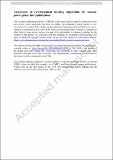| dc.contributor.author | Seurin, Paul | |
| dc.contributor.author | Shirvan, Koroush | |
| dc.date.accessioned | 2025-06-24T15:28:25Z | |
| dc.date.available | 2025-06-24T15:28:25Z | |
| dc.date.issued | 2024-01-29 | |
| dc.identifier.uri | https://hdl.handle.net/1721.1/159669 | |
| dc.description.abstract | The nuclear fuel loading pattern optimization problem belongs to the class of large-scale combinatorial optimization. It is also characterized by multiple objectives and constraints, which makes it impossible to solve explicitly. Stochastic optimization methodologies including Genetic Algorithms and Simulated Annealing are used by different nuclear utilities and vendors but hand-designed solutions continue to be the prevalent method in the industry. To improve the state-of-the-art, Deep Reinforcement Learning (RL), in particular, Proximal Policy Optimization is leveraged. This work presents a first-of-a-kind approach to utilize deep RL to solve the loading pattern problem and could be leveraged for any engineering design optimization. This paper is also to our knowledge the first to propose a study of the behavior of several hyper-parameters that influence the RL algorithm. The algorithm is highly dependent on multiple factors such as the shape of the objective function derived for the core design that behaves as a fudge factor that affects the stability of the learning. But also an exploration/exploitation trade-off that manifests through different parameters such as the number of loading patterns seen by the agents per episode, the number of samples collected before a policy update , and an entropy factor that increases the randomness of the policy during training. We found that RL must be applied similarly to a Gaussian Process in which the acquisition function is replaced by a parametrized policy. Then, once an initial set of hyper-parameters is found, reducing and until no more learning is observed will result in the highest sample efficiency robustly and stably. This resulted in an economic benefit of 535,000 - 642,000 $/year/plant. Future work must extend this research to multi-objective settings and comparing them to state-of-the-art implementation of stochastic optimization methods. | en_US |
| dc.publisher | Springer US | en_US |
| dc.relation.isversionof | https://doi.org/10.1007/s10489-023-05013-5 | en_US |
| dc.rights | Creative Commons Attribution-Noncommercial-ShareAlike | en_US |
| dc.rights.uri | http://creativecommons.org/licenses/by-nc-sa/4.0/ | en_US |
| dc.source | Springer US | en_US |
| dc.title | Assessment of reinforcement learning algorithms for nuclear power plant fuel optimization | en_US |
| dc.type | Article | en_US |
| dc.identifier.citation | Seurin, P., Shirvan, K. Assessment of reinforcement learning algorithms for nuclear power plant fuel optimization. Appl Intell 54, 2100–2135 (2024). | en_US |
| dc.contributor.department | Massachusetts Institute of Technology. Department of Nuclear Science and Engineering | en_US |
| dc.relation.journal | Applied Intelligence | en_US |
| dc.eprint.version | Author's final manuscript | en_US |
| dc.type.uri | http://purl.org/eprint/type/JournalArticle | en_US |
| eprint.status | http://purl.org/eprint/status/PeerReviewed | en_US |
| dc.date.updated | 2025-03-27T13:48:26Z | |
| dc.language.rfc3066 | en | |
| dc.rights.holder | The Author(s), under exclusive licence to Springer Science+Business Media, LLC, part of Springer Nature | |
| dspace.embargo.terms | Y | |
| dspace.date.submission | 2025-03-27T13:48:26Z | |
| mit.journal.volume | 54 | en_US |
| mit.license | OPEN_ACCESS_POLICY | |
| mit.metadata.status | Authority Work and Publication Information Needed | en_US |
